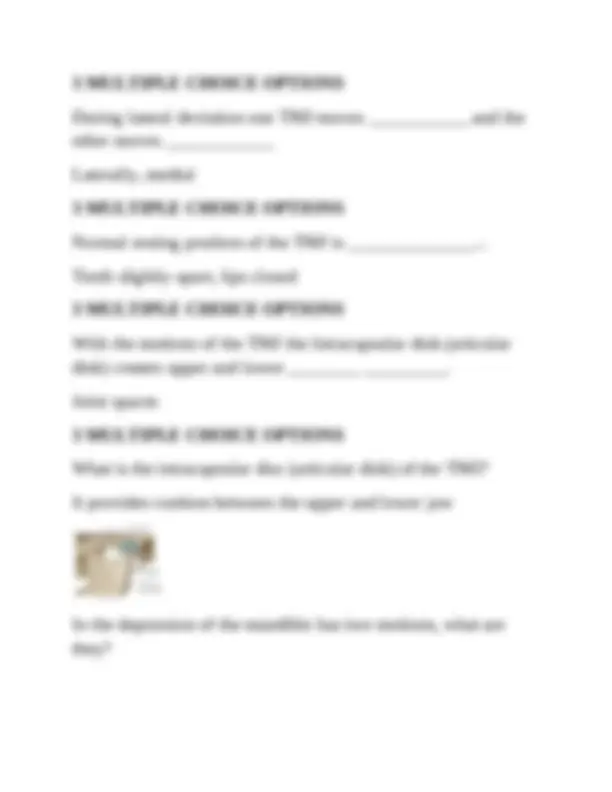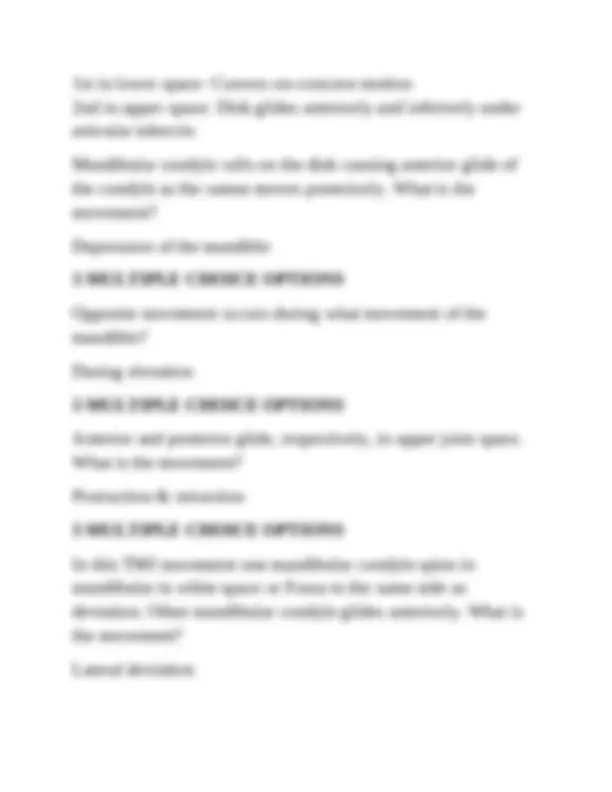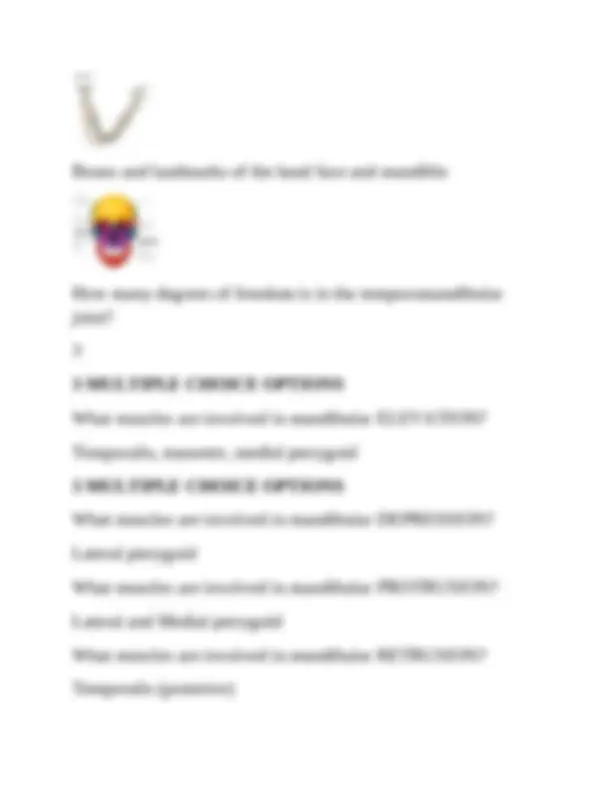





Study with the several resources on Docsity

Earn points by helping other students or get them with a premium plan


Prepare for your exams
Study with the several resources on Docsity

Earn points to download
Earn points by helping other students or get them with a premium plan
Community
Ask the community for help and clear up your study doubts
Discover the best universities in your country according to Docsity users
Free resources
Download our free guides on studying techniques, anxiety management strategies, and thesis advice from Docsity tutors
A series of questions and answers related to the temporomandibular joint (tmj), covering its anatomy, movements, muscles involved, and common pathologies. It is a valuable resource for students studying kinesiology, anatomy, or related fields, offering a concise overview of tmj function and clinical considerations.
Typology: Exams
1 / 7

This page cannot be seen from the preview
Don't miss anything!




TMJ Clinical Kinesiology Ch 14 Questions With Complete Solutions Two bony parts on the head? Cranium & face 3 MULTIPLE CHOICE OPTIONS What type of joint is the TMJ? one synovial joint (hinge & gliding) Where is the articulation on the TMJ? Between the mandibula-jaw-and the temporal bone What are the motions of the TMJ? Depression, elevation, protraction (protrusion), Retraction (retrusion), lateral deviation What is the TMJ movement of mandibular depression? Lowering the mandible-opening the mouth What is the TMJ movement of mandibular Elevation? Raising the mandible-closing the mouth What is the TMJ movement of mandibular Protraction (protrusion)? Moving the mandible anteriorly
What is the TMJ movement of mandibular Retraction (retrusion)? Moving the mandible posteriorly What is the TMJ movement of mandibular Deviation? Side to side motion What plane and axis does mandibular depression occur? Sagittal plane & frontal axis What plane and axis does mandibular Elevation occur? Sagittal plane & frontal axis What plane and axis does mandibular Protraction (protrusion) occur? Horizontal plane & vertical axis What plane and axis does mandibular Retraction (retrusion) occur? Horizontal plane & vertical axis What plane and axis does mandibular Lateral deviation occur? Horizontal plane & vertical axis Movement of TMJs occurs simultaneously and identically for all motion except ________________ Lateral deviation
1st in lower space- Convex-on-concave motion 2nd in upper space: Disk glides anteriorly and inferiorly under articular tubercle. Mandibular condyle rolls on the disk causing anterior glide of the condyle as the ramus moves posteriorly. What is the movement? Depression of the mandible 3 MULTIPLE CHOICE OPTIONS Opposite movement occurs during what movement of the mandible? During elevation 3 MULTIPLE CHOICE OPTIONS Anterior and posterior glide, respectively, in upper joint space. What is the movement? Protraction & retraction 3 MULTIPLE CHOICE OPTIONS In this TMJ movement one mandibular condyle spins in mandibular in white space or Fossa to the same side as deviation. Other mandibular condyle glides anteriorly. What is the movement? Lateral deviation
Bones and landmarks of the head face and mandible How many degrees of freedom is in the temporomandibular joint? 3 3 MULTIPLE CHOICE OPTIONS What muscles are involved in mandibular ELEVATION? Temporalis, masseter, medial pterygoid 3 MULTIPLE CHOICE OPTIONS What muscles are involved in mandibular DEPRESSION? Lateral pterygoid What muscles are involved in mandibular PROTRUSION? Lateral and Medial pterygoid What muscles are involved in mandibular RETRUSION? Temporalis (posterior)
The resistance arm shortens making it easier to chew or chomp on object. Define the pathology when an individual clenches or grinds teeth? Bruxism 3 MULTIPLE CHOICE OPTIONS What is it when an individual experiences is disk movement in the TMJ? "Locking" 3 MULTIPLE CHOICE OPTIONS